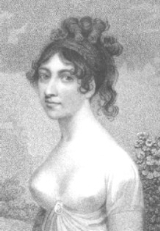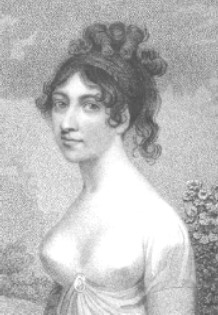
Charlotte Dacre
Encyclopedia
 |
Charlotte Dacre was an English author of Gothic novels.
Most references to her today are under the name Charlotte Dacre, but she first wrote under the pseudonym
Pseudonym
A pseudonym is a name that a person assumes for a particular purpose and that differs from his or her original orthonym...
Rosa Matilda, and later adopted a second pseudonym to tease and confuse her critics. Charlotte Dacre was born Charlotte King, and later became Mrs Byrne upon her marriage to Nicholas Byrne.
She was the daughter of John King, born Jacob Rey (c.1753–1824), a moneylender and radical writer well known in London society. Her father divorced her mother, Sara, née Lara, under Jewish law in 1784 before setting up home with the dowager countess of Lanesborough. She had a sister named Sophia.
Charlotte Dacre married Nicholas Byrne, a widower, on July 1 1815. She already had three children with him: William Pitt Byrne
William Pitt Byrne
William Pitt Byrne was a British newspaper editor and proprietor of The Morning Post.He graduated from Trinity College, Cambridge with a B.A. and M.A....
(born 1806), Charles (born 1807) and Mary (born 1809). He was an editor and future partner of London's The Morning Post newspaper where the author Mary Robinson
Mary Robinson (poet)
Mary Robinson was an English poet and novelist. During her lifetime she is known as 'the English Sappho'...
was the poetry editor and an influence on a young Charlotte Dacre who began her writing career by contributing poems to the Morning Post under the pseudonym "Rosa Matilda."
As a romance novelist, Dacre cast heroines in a way quite different from the norm of the early 19th century that called for ladies of decorum and good taste. Her style was more like that of the male authors of her era, creating aggressive and often physically violent female characters who demonstrate powerful sexual desires and ambition. Dacre usually constructed this behaviour in a way that can be at least in part justified by the actions of others.
Of her four major novels, Zofloya
Zofloya
Zofloya; or, The Moor: A Romance of the Fifteenth Century is an 1806 English Gothic novel by Charlotte Dacre, writing as Rosa Matilda. It was her second novel. It was published in three parts, and later collected into a single volume. It was highly criticized during its publication, due to its...
is the best known today, and sold well on its release in 1806; it was translated into both German and French. In this story, a female character stalks, brutally attacks, and then murders a girl whom she sees as a sexual rival. Yet, despite the brutality, the story has its underlying moral messages in that young women are warned against the dangers of lust.
In the literary world, Charlotte Dacre has remained in virtual obscurity for nearly two centuries. However, her work was admired by some of the literary giants of her day and her novels influenced Percy Shelley who thought highly of her style and creative skills. She is believed to be one of the numerous targets of Lord Byron's satirical poem English Bards and Scotch Reviewers, mentioned in the lines:
- Far be't from me unkindly to upbraid
- The lovely 's prose in masquerade,
- Whose strains, the faithful echoes of her mind,
- Leave wondering comprehension far behind.
Partial bibliography
- Hours of Solitude (Poems) (1805)
- Confessions of the Nun of St. Omer (1805)
- ZofloyaZofloyaZofloya; or, The Moor: A Romance of the Fifteenth Century is an 1806 English Gothic novel by Charlotte Dacre, writing as Rosa Matilda. It was her second novel. It was published in three parts, and later collected into a single volume. It was highly criticized during its publication, due to its...
(1806) - The Libertine (1807)
- The Passions (1811)
- George the Fourth, a Poem (1822)
External links
- Charlotte Dacre, from Wikinfo, licensed under the GNU Free Documentation LicenseGNU Free Documentation LicenseThe GNU Free Documentation License is a copyleft license for free documentation, designed by the Free Software Foundation for the GNU Project. It is similar to the GNU General Public License, giving readers the rights to copy, redistribute, and modify a work and requires all copies and...
.

